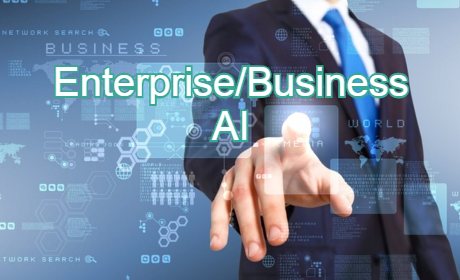
Enterprise/Business AI
The course is about:
How AI solves enterprise/business problems
How to build an AI system for enterprise/business
COURSE DESCRIPTION
Enterprise AI is the topic to embed AI methodology into the very core of the organization. In this course, you will learn how to build, deploy, and monitor predictive data flows to solve problems like fraud, churn, supply chain optimization, predictive maintenance, and much more.
The Enterprise AI course is taught by a group of senior engineers from the United States.
COURSE OBJECTIVES
Upon successful completion of this course, the students will be able to:
- Understand the AI algorithms for enterprise applications;
- Understand how to apply AI-based methods to solving practical business problems;
- Understand implications of AI for business strategies;
- Understand the major AI algorithms used in various enterprise operations;
- Understand how to design scalable AI systems for enterprises;
- Understand how to initiate, implement, and deploy AI applications in enterprises.
PREREQUISITES
Students are required to have prior knowledge in the following areas:
- Machine Learning
- Deep Learning
- Reinforcement Learning
TEXTBOOKS
No textbooks available for this course as most contents are from the latest development of the area.
COURSE GRADING POLICY
Classroom Participations/Responses: 20%
Project: 50%
Final Exam: 30%
Attendance is mandatory for all class sessions. Students are subject to losing points for absences unless prior approval is obtained from Instructors or Teaching Assistants. Students receiving excused absences are required to watch the class recordings online as well as to fulfill any/all course requirements associated with missed class sessions.
COURSE CREDITS
The course contains 32 lecturing sessions and 32 office hours. The recommended number of credits for the course is 2.
MAIN CONTENTS
1. Artificial Intelligence for Enterprise
- Enterprise operations
- AI Algorithms focused
2. Demand Forecasting
- AI algorithms for demand forecasting
- Continuous learning for demand forecast models
3. Churn Analytics
- AI algorithms for churn analytics
- Building an end to end churn prediction model
4. Fraud Detection
- AI algorithms for fraud detection
- Fraud detection in financial industry
- Fraud detection in insurance industry
5. Value Optimization
- AI techniques for value optimization
- Optimize advertising campaigns
- Effectively allocate resources
6. Sales
- Data to Classes
- Insides sales rep workflow automation
- Improved lead, opportunity ranking and reminder
- Business Use Case Example: Classifying leads for improved conversion rate in sale funnel
7. Marketing
- Data to Clusters
- Ad content prediction
- AI based Ad buy and CPC optimization
- Business Use Case Example: Clustering customer behavior for improved click through rate in e-commerce
8. Customer Relationship Management
- Trend detection and prediction in customer relationship
- Manage customer churn
- Predict shifts in customer interests
- Customer satisfaction prediction
9. Intelligent Business Process Solutions
- Business process automation
- Process optimization
- Smart supply chain management
10. Enterprise AI Best Practices
- Building a scalable enterprise AI architecture
- Model management
- Model deployment
- Continuous learning
- Automated machine learning
STUDENT PROJECT
Students will propose solutions on how Artificial Intelligence is used in practical business settings by analyzing several business cases of deploying AI solutions in organizations across different industries from the world’s top companies and propose improvements to the solutions.
Students must submit a report for the project with the following contents:
- Problem identification & problem statement;
- Research on existing solutions from the market and analyze the pros and cons of the solutions;
- Make improvements to the existing solutions by leveraging the latest AI algorithms or techniques;
- Personal reflection of the project.
